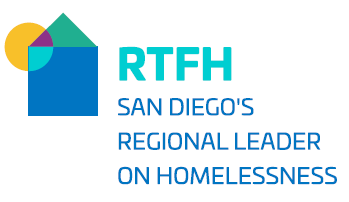RTFH is Responsible for Tracking and Analyzing Data, Finding Gaps in the System
SAN DIEGO, CA., April 20, 2021 – Addressing homelessness during a global pandemic has proven to be one of most formidable challenges for many communities over the past year. The Regional Task Force on Homelessness (RTFH), which is responsible for collecting, tracking and reporting out on a significant amount of real-time data as it pertains to homelessness in San Diego County, has created a Data and Performance Analysis of the region’s Homelessness Crisis Response System for 2020 so that service providers, elected officials, policy makers and members of the community can better understand how the region’s systems are performing toward helping San Diego’s homeless residents.
As it relates to homelessness, no one data point can adequately tell the entire story on its own. There are dozens of important statistical categories that are tracked and examined and must be put in proper context to truly understand how many people are becoming homeless and how many people are successfully exiting homelessness.
With the COVID-19 pandemic and lockdowns starting in March 2020, San Diego’s homeless system had to quickly adapt program delivery to keep people experiencing homelessness and the staff serving them safe, transition many staff and services to remote operations, and still continue to focus on providing services and housing assistance. While 2020 was unlike any year in modern history, it is important to review data to understand what happened within the homeless response system, to continue to improve services to support as many people as possible to successfully exit homelessness and remain stably housed, and to prevent people from becoming homeless in the first place.
“Because each person who experiences homelessness has their own individual needs, their own challenges and their own opportunities, it is important to understand that there are real people behind these numbers,” said Tamera Kohler, CEO of RTFH. “Despite our challenges being exacerbated by the pandemic, our goal remains to make homelessness rare, brief and non-recurring. Having a deep understanding of all the data points helps us find gaps in our system and make improvements where they are needed so that we can ultimately end homelessness in San Diego.”
Following are some key data points from the report. Data below represents all of San Diego County, between January 1, 2020 and December 31, 2020:
It is important to note that this data is dynamic, sometimes changing as often as daily. All data comes from the region’s Homeless Management Information System (HMIS), which tracks people’s participation in homeless services in real time, as opposed to the annual Point-In-Time (PIT) count, which is once-a-year census of people living in shelters and on the streets.
TOTAL PERSONS SERVED: 38,023, Comprising 32,277 Households
This number represents the total number of people in San Diego County who received services for any length of time via street outreach workers, a day center, shelter programs, rapid rehousing programs, and other supportive services. Services may include housing navigation, health and behavioral health care, meals, employment assistance, or more. Of those:
- Total Persons Served in 2019: 31,401
- Total Households Served in 2019: 26,082
- A total of 10,858 people were served in emergency shelter in 2020, an increase of 30% from 2019. Of those in shelter 8,687 were single adults and 643 were families.
The increase in persons served can largely be attributed to increased persons served in street outreach programs, emergency shelter, and homelessness prevention programs. Increased funding from the federal government through the Coronavirus Aid, Relief, and Economic Security (CARES) Act, state funds, and philanthropic funding helped provide new resources for shelter and other assistance during the pandemic.
FIRST TIME HOMELESS: 4,152 Individuals, 3,450 Households
This number represents the number of individuals or households who entered a shelter during the year and, of those, the number that have not been served by the homeless system in the past two years.
- First Time Homeless in all of 2019: 2,326 individuals, 1,910 households
- First Time Homeless in all of 2018: 2,483 individuals, 1,968 households
It is unknown if COVID-19 is the reason for the increase in 2020, as there have been eviction moratoriums in place at the federal and state levels, but it is well-known that the pandemic strained employment, healthcare, and housing configurations, which may have may have contributed to the increase.
TOTAL EXITS TO PERMANENT HOUSING: 2,518 Individuals, 1,753 Households
This number represents the number of people who found permanent housing via street outreach programs, a day center, shelter, rapid rehousing programs, and other supportive services. Of those:
- Total exits to permanent housing in 2019: 3,978 individuals, 2,680 households
- Total exits to permanent housing in 2018: 4,764 individuals, 3,049 households
- Including prevention programs and other permanent housing programs, a total of 6,028 total persons making up 4,049 households remained in or exited to a permanent housing setting
PERCENTAGE OF PEOPLE RETURNING TO HOMELESSNESS: 26% Within Two Years
The intent in measuring this is to understand housing stability for those who have previously exited the homelessness response system to permanent housing. Returning to the homelessness system is defined as entering a temporary housing program – emergency shelter, safe haven, and transitional housing or entering a permanent housing program – rapid re-housing or permanent supportive housing.
- Percentage of people returning to homelessness within two years in 2019: 24%
- Percentage of people returning to homelessness within two years in 2018: 24%
###
